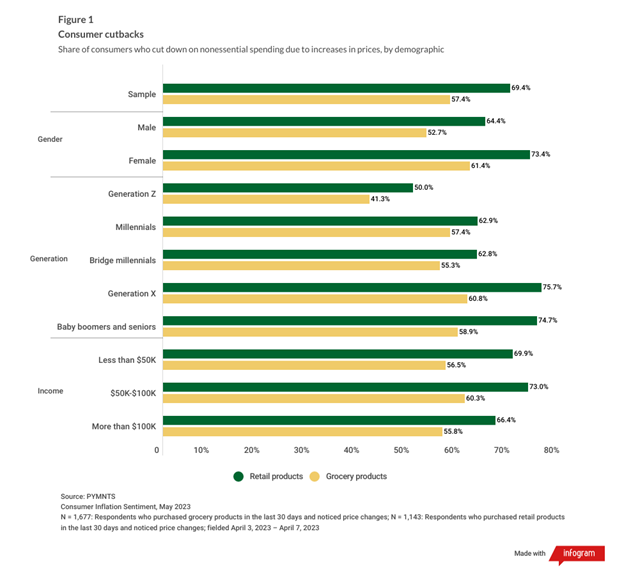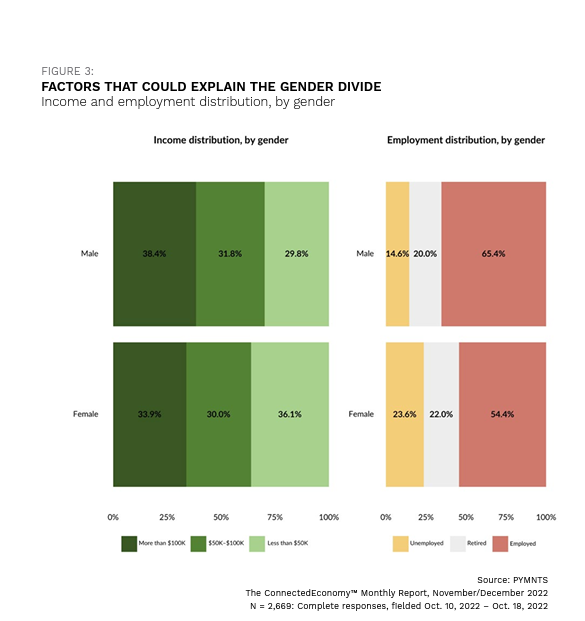Female, Gen X, Middle-Income Shoppers Leading Wave of Spending Cutbacks

When examining consumer spending habits, top-down numbers may not tell the whole story.
Who exactly is spending and who is not is vital data for retailers, merchants and any other consumer-facing business seeking to market to distinct segments. While total sample size for the PYMNTS’ May “Consumer Inflation Sentiment” report may be useful for a top-down view of the market, a closer look at the demographics may be more helpful to those with more defined audiences. After all, how else can a business understand its target customer’s specific needs?

In the above chart’s sample size, 69% of consumers cut down their retail purchases due to price increases, with 57% doing the same for groceries. Not great numbers, to be sure, but a closer look at demographics shows that this spending pullback is being led by female consumers, who far outpace their male counterparts in cutting costs. Our data finds a 9% difference for both grocery and retail items.
Income and employment may explain most of this difference, illustrated in PYMNTS’ “ConnectedEconomy™ Monthly Report: Gender Divide.”

Men tend to be paid more than women, being 4 percentage points more likely to earn $100,000 per year and 6 percentage points less likely to earn less than $50,000 per year. The closest bracket to being evenly distributed were earners making between $50,000 and $100,000 annually — and even there, the slightly greater share of men relative to women highlights this imbalance. Employment distribution was also found to be uneven, with 65% of males employed compared to 54% of females and just 15% of males unemployed (the share for females is 24%). With both an unequal income and employment distribution, it follows that women may be cutting costs more than men.
Beyond gender differences, PYMNTS’ data has found generational differences, and Gen X is pulling back most. Data shows that 76% are trimming back their retail purchases, and 61% are doing the same for groceries. The reason for them eking ahead of other age cohorts may presumably be due to the outsized financial burden the generation as a whole has been expected to take on. Stuck in the middle of possibly caring for both aging parents and growing children and carrying the highest levels of student loan debt has clearly left Gen X scrambling to stretch their budgets. Just behind Gen X in cutting back are baby boomers and seniors, as 75% of these consumers have cut back on retail spending and another 59% decreasing grocery spend. Mostly in retirement age, this cost-cutting may be due to this cohort’s struggle to meet the cost of living on a fixed income.
By income level, consumers cutting back the most tended to make between $50,000 and $100,000 annually. With 73% reducing their retail spend and 60% cutting down on groceries, the share of these consumers to do so beat both those making above $100,000 per year and those making below $50,000 by multiple percentage points. One explanation is that these middle-income consumers are caught between a rock and a hard place, not enjoying the same financial stability as higher-income consumers but also often not qualifying for benefits and programs designed for those making less, such as SNAP and rental assistance. And with dollars not stretching as far as they used to, spending less may be the most logical option for these consumers.
Merchants, retailers and others dependent on consumer spending are up against longer-than-expected challenges as the road to economic recovery continues its rocky path. Taking a deeper look at who is pulling back — and uncovering the potential for women, Gen Xers, and middle-income consumers to do so — may give these organizations the insights they need to reach their chosen market.

